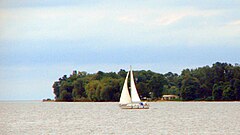
Back Bay of Quinte CEB Baie de Quinte French Bay of Quinte Scots/Gaelic 퀸트만 Korean Bay of Quinte Swedish Квінті (затока) Ukrainian

The Bay of Quinte (/ˈkwɪnti/) is a long, narrow bay shaped like the letter "Z" on the northern shore of Lake Ontario in the province of Ontario, Canada. It is just west of the head of the Saint Lawrence River that drains the Great Lakes into the Gulf of Saint Lawrence. It is located about 200 kilometres (120 mi) east of Toronto and 350 kilometres (220 mi) west of Montreal.
The name "Quinte" is derived from "Kenté" or Kentio, an Iroquoian village located near the south shore of the Bay. Later on, an early French Catholic mission was built at Kenté, located on the north shore of what is now Prince Edward County, leading to the Bay being named after the Mission.[1] Officially, in the Mohawk language, the community is called Kenhtèːke, which means "the place of the bay". The Cayuga name is Tayędaːneːgęˀ or Detgayęːdaːnegęˀ, "land of two logs."[2][3]
The Bay, as it is known locally, provides some of the best trophy walleye angling in North America as well as most sport fish common to the great lakes. The bay is subject to algal blooms in late summer. Zebra mussels as well as the other invasive species found in the Great Lakes are present.
The Quinte area played a vital role in bootlegging during prohibition in the United States, with large volumes of liquor being produced in the area, and shipped via boat on the bay to Lake Ontario finally arriving in New York State where it was distributed. Prohibition-era illegal sales of liquor accounted for many fortunes made in and around Belleville.
Tourism in the area is significant, especially in the summer months due to the Bay of Quinte and its fishing, local golf courses, provincial parks, and wineries.
- ^ Great Canadian Lakes, Lake Ontario - Saving Souls in Kente Archived March 9, 2009, at the Wayback Machine Retrieved: 2010-04-15
- ^ "Cayuga: Our Oral Legacy - Home. Cayuga Digital Dictionary". Archived from the original on 2012-03-26. Retrieved 2012-05-27.
- ^ Bruce Elliott Johansen; Barbara Alice Mann (2000). Encyclopedia of the Haudenosaunee (Iroquois Confederacy). Greenwood Publishing Group. p. 320. ISBN 978-0-313-30880-2. Retrieved 11 December 2011.
